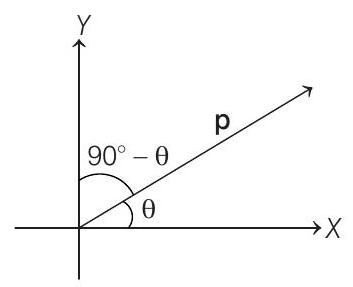Electrostatics 4 Question 7
7. An electric dipole has a fixed dipole moment $\mathbf{P}$, which makes angle $\theta$ with respect to $X$-axis. When subjected to an electric field $\mathbf{E} _1=E \hat{\mathbf{i}}$, it experiences a torque $\mathbf{T} _1=\pi \hat{\mathbf{k}}$. When subjected to another electric field $\mathbf{E} _2=\sqrt{3} E _1 \hat{\mathbf{j}}$, it experiences a torque $\mathbf{T} _2=-\mathbf{T} _1$. The angle $\theta$ is
(2017 Main)
(a) $45^{\circ}$
(b) $60^{\circ}$
(c) $90^{\circ}$
(d) $30^{\circ}$
Show Answer
Solution:

Torque applied on a dipole, $\tau=p E \sin \theta$
where, $\theta=$ angle between axis of dipole and electric field.
For electric field $E _1=E \hat{\mathbf{i}}$.
it means field is directed along positive $X$ direction, so angle between dipole and field will remain $\theta$, therefore torque in this direction
$$ E _1=p E _1 \sin \theta $$
In electric field $E _2=\sqrt{3} E \hat{j}$, it means field is directed along positive $Y$-axis, so angle between dipole and field will be $90-\theta$
Torque in this direction $T _2=p E \sin \left(90^{\circ}-\theta\right)$.
$$ =p \sqrt{3} E _1 \cos \theta $$
According to question $\tau _2=-\tau _1 \Rightarrow\left|\tau _2\right|=\left|\tau _1\right|$
$$ \begin{aligned} & \therefore \quad p E _1 \sin \theta=p \sqrt{3} E _1 \cos \theta \\ & \tan \theta=\sqrt{3} \Rightarrow \tan \theta=\tan 60^{\circ} \\ & \therefore \quad \theta=60^{\circ} \end{aligned} $$






